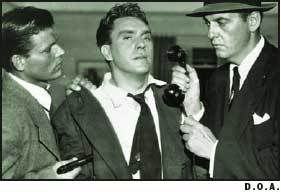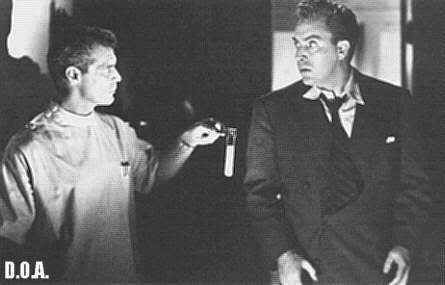Existential anxieties of film noir

The film DOA does put existential anxieties of film noir at the forefront of its narration. The “walking dead man” metaphor that usually plagues film noir’s themes of a fatalistic protagonist is inevitably drawn into a dark dangerous world where he eventually meets his demise. The very idea that Frank cannot escape his impending doom and pushes on to find his murderer (or blackmailer, criminal, etc.) is a very existential noir characteristic. Frank is shown as the opening credits roll roaming down a long hallway in search or something or someone, and seemingly injured. The dramatic music seems to help the narration and create the feeling among the audience that something dramatic will soon follow. After Frank reports to investigators that he was murdered in San Francisco, audiences are not sure if Frank is crazy or dreaming. But when the head investigator identifies Frank from the file, we are convinced that he must be a “dead man walking”.
I think that this idea of the metaphor becoming the text, rather than the subtext, works interestingly within the narration of this film. I imagine it is quite an innovative idea among noir plots that the actual victim of a murder would be able to discover through their own “legwork” how or who murdered them. In most instances of a noir, a victim of a murder discovers their fate much too late, and in some occasion are not even seen on-screen by audiences. This film is seemingly darker in my opinion than other noir films because 1.)An undeserving character dies, 2.)The amount of psychotic behavior is intense, 3.)And the treatment of women is a bit tough for its time. This semester we have seen films where our protagonist dies, and we’ve seen many others noir films with psychotic behavior and screwed world views. We have even seen films where our fatal noir heroes have been verbally tough & rough with the women. Alas, DOA combines all three of these characteristics in our protagonist with very important (and somewhat cheesy) social values, which are set against real-life locations and provide greater evidence of the isolation that Frank feels as he slowly dies. I think that the audience is hypnotically draws us into the events surrounding Frank’s undeserving death and we empathize for his demise throughout the re-telling of it.

The narration in this film does seem a bit negative and harsh for our protagonist. All in all, what did Frank Bigelow do to deserve such an extreme fate? It seems to me that the moral of the film suggests that one must appreciate life because we are not intended to “walk the earth” aimlessly unaware of what we possesses. DOA seems to challenges the everyday monotony that plagues most Americans who drift through life unappreciative of their surroundings. Specifically, I think this film addresses the particularly aging man who can’t seem to commit to a way of life (the American dream with a wife and kids), and lacks recognition for how fulfilling such a life can be. Up until he finds out from his first doctor what is causing his sickness and eventual death, Frank is avoiding marriage to Paula and possessing a wander eye for other blonds, while aimless living his life with little enjoyment or fulfillment. Additionally, Frank’s wandering eye somehow communicates that Frank has been or will be unfaithful to Paula. Yet, on-screen Frank never actually partakes in committing adultery with any of the blonds which tempt his interest. The catalyst for him discovering Paula’s value to his life, and the regret of not having children only becomes apparent when he realizes he is about to die. This is not an uncommon idea in real life off-screen. Frank is soon running through the scenically real streets of LA mad and desperate. Running out of breath, he stops at a news stand where we see a perfectly fitted magazine for this scene which reads “Life”. Then there is a short montage like scene where an unknown couple dramatically meets and then kisses indicating that Frank will miss out on this type of relationship, and it also communicates a new longing for Paula. Secondly, we see a little girl lose her ball and Frank picks it up to give it back to her, which is the indication that he regrets not ever being able to have children of his own. To the audience, it would only seem fair that Frank gets to survive his doomed fate; especially now when his values have changed.
I have seen plenty of neo-noir films and I can’t recall many films released after the 90’s where the main middle aged Caucasian protagonist is killed through a luminous poisoning. Although many films today have elements similar to that in noir films, they cannot really be classified as “true” noir. I have one film in mind that might be considered closet to DOA, but that is hard to say since I have not seen ALL the neo-noir films which have been released. Still, I do not think Bourne Identity could be remotely related to classic noir, yet the narrative is the most similar to DOA that I can come up with. Jason Bourne is a man who everyone thinks is dead at the opening of the film. Although Bourne is not an ordinary “Joe’ like Frank because of his mechanical like governmental killer training, he was an ordinary Foreign Service officer named David Webb (his former self) before he was Bourne. For most of the film, Bourne is searching for his true identity, and trying to find his murderer, while forging a strong relationship with the only person he “knows”, Marie, a woman he has just met. Jason, unlike Frank, lives on and even gets to reap the benefits of realizing how important it is to be “connected” to someone.
Labels: D.O.A, DOA, film noir, Frank Bigelow, noir












